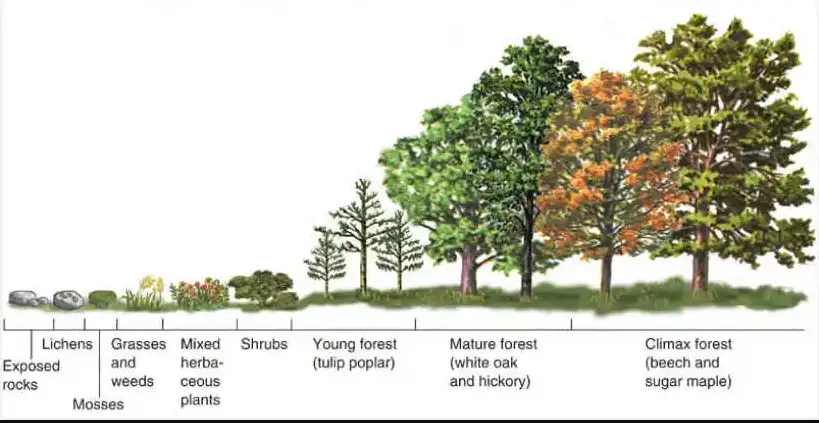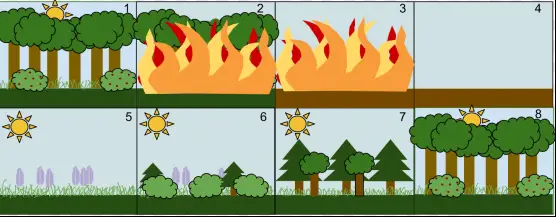Ecological succession is a fundamental concept in environmental science that explains the gradual process through which ecosystems change and develop over time. Key to this concept are two primary types of succession: autogenic and allogenic. Each plays a critical role in how landscapes evolve, but they operate through distinctly different mechanisms and have varied implications on the environment.
Autogenic succession occurs due to internal factors within the ecosystem itself, such as changes in soil composition or the natural growth of vegetation, which alter the environment to support different types of species over time. Allogenic succession, on the other hand, is driven by external forces. These could be climatic changes, natural disasters, or human activities that modify the ecosystem’s structure and the species composition from the outside.
Understanding these types of succession not only enriches our knowledge of ecological dynamics but also enhances our ability to manage natural resources and plan for sustainable development. Insights into how ecosystems respond to different influences help in predicting ecological shifts and planning for biodiversity conservation under changing global conditions.

Ecological Succession Basics
What is Succession?
Ecological succession is the dynamic process of change within an ecosystem over time. This evolution occurs as different species colonize, mature, and potentially get replaced by other species in a series of predictable stages. The end result often stabilizes into a climax community, which can persist until disrupted by an environmental change.
Types of Succession
Succession is categorized into several types, each shaped by unique factors and processes:
- Primary Succession: This type starts from lifeless areas where soil has not yet formed, such as lava flows, bare rock exposed after a landslide, or areas left after a glacier recedes.
- Secondary Succession: Occurs in areas where an existing community has been removed; it’s typically faster than primary succession as soil is already present.
- Cyclic Succession: Regular, predictable changes within an established ecosystem, often driven by seasonal variations or life cycle patterns of dominant species.
- Autogenic and Allogenic Succession: Driven by internal and external factors, respectively, these types highlight different mechanisms that influence ecological development.
Autogenic Succession Explained
Autogenic Succession Defined
Autogenic succession is a process driven by the ecosystem itself, through the activities of the community’s organisms. As species within an ecosystem alter their own environment, they pave the way for new and different species to succeed them. This type of succession is a direct result of the biological activities of the resident species, primarily through alterations in soil composition and the local microclimate.
Autogenic Mechanisms
Several key mechanisms underpin autogenic succession:
- Soil Buildup: Decaying plant matter and microbial activity enrich the soil, making it suitable for different plant species that require richer soil.
- Shade Creation: As taller plants grow, they create shade, altering light levels and enabling shade-tolerant species to thrive.
- Modification of Water Availability: The root systems of developing plants can change soil permeability and water retention, impacting species that prefer drier or wetter conditions.
Examples of Autogenic Succession
One classic example of autogenic succession can be seen in forested areas:
- Forest Development: In a newly formed soil bed, grasses and other small plants initially dominate. Over time, shrubs outcompete these early colonizers, followed by young trees and eventually mature forests. Each stage modifies the environment to facilitate the next, culminating in a climax forest community.
Allogenic Succession Explained
Allogenic Succession Defined
Allogenic succession results from external environmental changes. These changes are independent of the current community and often occur due to factors like floods, wildfires, or human activities such as land clearing and agriculture, which drastically alter the landscape and the conditions for the types of species that can thrive.
Allogenic Mechanisms
The mechanisms of allogenic succession involve significant alterations imposed on an ecosystem from outside:
- Climate Change: Shifts in climate can alter temperature and precipitation patterns, forcing a change in the species composition of an area.
- Natural Disasters: Events such as volcanic eruptions or major storms can reset ecological stages, starting succession anew under different conditions.
- Human Impact: Agricultural development, urbanization, and pollution can drastically change the biological makeup of an ecosystem, often necessitating a different successional path.
Examples of Allogenic Succession
A notable instance of allogenic succession is observed in ecosystems following large-scale natural disturbances:
- Post-Fire Recovery: After a forest fire, the immediate environment is drastically altered. Nutrient-rich ash may cover the soil, and without the original vegetative cover, new plant species, often different from those before the fire, colonize the area. This succession leads eventually to the restoration of a forest ecosystem, though it may differ from the original in species composition due to the altered conditions.
Key Differences Highlighted
Comparison of Mechanisms
The fundamental difference between autogenic and allogenic succession lies in their driving forces. Autogenic succession is propelled by the internal dynamics of an ecosystem. The activities and interactions of species within the habitat gradually change environmental conditions, leading to the succession of ecosystems. Conversely, allogenic succession is influenced by external environmental forces such as climate changes, natural disasters, or human interventions that impose new conditions on an ecosystem, forcing it to adapt.
Impact on Ecosystems
Each type of succession has a distinct impact on the structure and function of ecosystems:
- Autogenic Succession: Typically leads to increased soil fertility as organic material accumulates and decomposes. This process supports a wider variety of plant species over time, which in turn supports diverse animal populations. The gradual nature of autogenic succession allows ecosystems to develop complex food webs and robust ecological interactions.
- Allogenic Succession: Often results in more abrupt changes. For instance, after a flood or fire, the initial environment may be less diverse but over time can become highly specialized depending on the new conditions. This type of succession can either enhance or reduce biodiversity depending on the severity and nature of the external disturbance.
Timeframe of Succession
The timeline of ecological succession varies greatly between autogenic and allogenic types:
- Autogenic Succession: Usually unfolds over several decades or even centuries as changes are gradual and internally driven. The pace depends on the growth rates of dominant species and how significantly they alter their environment.
- Allogenic Succession: Can occur rapidly following an external disturbance. Recovery times can vary widely, however, depending on the extent of the disturbance and the resilience of the ecosystem.
Ecological Implications
Role in Habitat Restoration
Understanding both types of succession is crucial for effective ecological restoration and conservation efforts. Knowledge of autogenic processes helps in predicting how ecosystems might recover on their own over time, allowing conservationists to support these processes naturally. Allogenic knowledge is vital for restoring ecosystems that have undergone severe disturbances, such as those impacted by industrial pollution or natural disasters.
Impact on Biodiversity
The effects on biodiversity also differ:
- Autogenic Succession: Generally promotes increased biodiversity through gradual habitat enhancement. As the ecosystem matures, it supports a larger number of species at various trophic levels.
- Allogenic Succession: The impact on biodiversity can be mixed. While some disturbances may create new habitats and opportunities for colonization by diverse species, others might simplify the ecosystem, reducing its overall biodiversity.
Practical Applications
Management of Natural Resources
Insights from studying both types of succession can guide the sustainable management of natural resources. For instance, understanding autogenic succession can help in the management of forests, fisheries, and wildlife by predicting how ecosystems might evolve under minimal human interference. Knowledge of allogenic succession is essential for planning recovery after ecological disturbances such as mining or large-scale logging.
Urban Planning and Ecology
The principles of ecological succession are increasingly applied in urban planning to enhance the ecological balance and sustainability of urban environments. This includes:
- Designing Green Spaces: Urban planners use knowledge of succession to design parks and green spaces that evolve naturally over time, requiring less maintenance and providing greater ecological benefits.
- Flood Management: Understanding how ecosystems naturally recover from flooding can inform the design of urban water management systems that mimic natural processes, potentially reducing the impact of floods in urban areas.
Frequently Asked Questions
What is ecological succession?
Ecological succession is the process by which the structure of a biological community evolves over time. It involves species in one stage being gradually replaced by different species in subsequent stages, leading to a stable or climax community.
How does autogenic succession differ from allogenic succession?
Autogenic succession is driven by the ecosystem itself, through internal processes like soil enrichment and vegetation growth altering the habitat. Allogenic succession results from external environmental changes, such as floods or human interference, which introduce new conditions that alter community composition.
Why is understanding succession important for ecological management?
Knowledge of succession processes helps in the management and restoration of ecosystems. It allows conservationists and land managers to predict how ecosystems might change over time and to implement strategies that promote desirable outcomes in terms of biodiversity and ecosystem health.
Can human activities influence ecological succession?
Yes, human activities can significantly influence ecological succession. Activities such as deforestation, land use changes, and pollution can alter natural succession paths, sometimes leading to degraded ecosystems or the need for active restoration efforts.
Conclusion
The distinctions between autogenic and allogenic succession provide a lens through which we can view the intricate processes that govern ecological transformations. By examining these processes, scientists and environmental managers can better understand the dynamics of ecosystems and make informed decisions that help maintain or restore ecological balance. This knowledge is vital as we face environmental challenges that require us to predict and manage changes in natural habitats effectively.
Moreover, understanding these succession types enriches our ability to foster biodiversity and sustain ecosystem functions, which are crucial for the health of our planet and the survival of its diverse species. These insights thus play a pivotal role in shaping conservation strategies and sustainable management practices that will benefit future generations.

